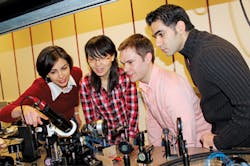A laser-powered terahertz (THz) source and detector system transmits with 50 times more power, and receives with 30 times greater sensitivity, than existing technologies, according to its developers.1 The effect is 1,500 times greater power for deep tissue imaging and other applications—without the damaging effects of x-rays. With the technology, you could see deeper into tissues, said Mona Jarrahi, assistant professor of electrical engineering and computer science at the University of Michigan (U-M; Ann Arbor, MI), who led the work.
The researchers achieved the advance by coupling laser light with surface plasmon waves. This created a funnel able to carry the light to select nanoscale regions near device electrodes that feed an antenna—provided to transmit and receive the THz signal. The excited surface plasmon waves deliver photons to precise locations quickly and efficiently, said Jarrahi.
Jarrahi feels confident that the sources' output power and the detectors' sensitivity can be further improved by designing optical funnels with even tighter focusing capabilities.
Ted Norris, director of the U-M Center for Photonic and Multiscale Nanomaterials, says the innovation "gets right to the central issue in photoconductive THz devices, which is collecting all the charge. Since every application benefits from increased sensitivity...I expect this approach to be implemented widely."
Not all THz systems are powered by lasers, but those that are have been the most successful commercially, because of the cost-effectiveness, compactness, and high-power of sources now available.
1. C. W. Berry, N. Wang, M. R. Hashemi, M. Unlu, and M. Jarrahi, Nat. Comm., 4, 1622 (2013).

